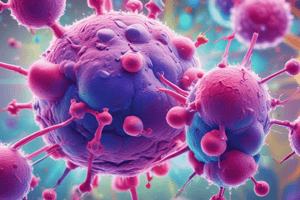Podcast
Questions and Answers
Is class switching the same as VDJ recombination?
Is class switching the same as VDJ recombination?
False (B)
B cells can ________ the type of heavy chain they use for their antibodies during an immune response.
B cells can ________ the type of heavy chain they use for their antibodies during an immune response.
change
Where does class switching occur?
Where does class switching occur?
secondary lymphoid organs
What does class switching ensure?
What does class switching ensure?
Is the variable heavy chain affected in class switching?
Is the variable heavy chain affected in class switching?
What immunoglobulin do all B cells start by secreting?
What immunoglobulin do all B cells start by secreting?
Activated B cells presenting antigen to T helper cells receive cytokine signals that induce them to __________________ to other isotypes.
Activated B cells presenting antigen to T helper cells receive cytokine signals that induce them to __________________ to other isotypes.
What is required for class switching?
What is required for class switching?
Is the part not involved in VDJ recombination still involved in the genome?
Is the part not involved in VDJ recombination still involved in the genome?
To switch to a new isotype, the intervening heavy chain ________ regions have to be cut out of the DNA.
To switch to a new isotype, the intervening heavy chain ________ regions have to be cut out of the DNA.
Does class switching use the same or different enzymes than VDJ recombination?
Does class switching use the same or different enzymes than VDJ recombination?
Where can recombination take place?
Where can recombination take place?
_______________ DNA is cut out and a new constant region is placed adjacent to the VDJ region.
_______________ DNA is cut out and a new constant region is placed adjacent to the VDJ region.
What influences the class of antibody made by B cells?
What influences the class of antibody made by B cells?
Flashcards are hidden until you start studying
Study Notes
Class Switching Overview
- Class switching is a process allowing B cells to change the type of heavy chain expressed in their antibodies during an immune response.
- It ensures that only one receptor is expressed on the surface of each B cell, maintaining specificity in immune responses.
Mechanism of Class Switching
- Activated B cells present antigens to T helper cells and receive cytokine signals that induce them to switch to other antibody isotypes.
- Class switching occurs primarily in secondary lymphoid organs, such as lymph nodes and spleens.
- In class switching, intervening heavy chain constant regions are removed from the DNA, placing downstream constant regions adjacent to the recombined variable domain.
Genetic Implications
- The variable heavy chain remains unaffected during class switching; only constant regions are modified.
- Different enzymes are used for class switching compared to VDJ recombination, involving specific mechanisms for heavy chain rearrangement.
- Recombination can occur between switch regions within the DNA to facilitate the switch to different antibody isotypes.
Immunological Context
- All B cells initially secrete IgM antibodies before undergoing class switching.
- CD40/CD40L interactions are essential for the class switching process.
- The type of cytokine produced by T helper cells influences which class of antibody is made by B cells.
Studying That Suits You
Use AI to generate personalized quizzes and flashcards to suit your learning preferences.




